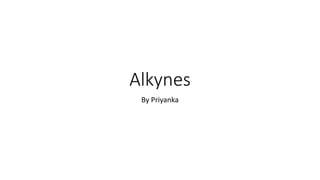
Alkynes
- 2. Introduction to Alkynes • Alkynes are also unsaturated hydrocarbons but they are more unsaturated than alkenes. Alkynes are characterized by the presence of carbon-carbon triple bond (C≡C) in hydrocarbon molecule. • The triple bond of alkynes consists of a strong sigma (σ) two weak pi(π) bonds. In alkynes triple bonded carbon atom are sp hybridized. The σ – bond is formed by the overlap of sp- hybrid orbitals and the π bonds are formed by the separated overlap of the two P-orbitals. Carbon_x0002_Carbon distance in acetylene is 1.20Ao and C-H bond length is 1.06Ao • As acetylene molecule is linear, the H-C-C bond angle is 180o • Acetylene and 1-alkynes are acidic in character this is because of more S-character of the C-H bond thus the electrons of the C-H bond in 1-alkynes are more strongly hold by the carbon nucleus and hydrogen atom of ≡C-H can be easily removed.
- 3. Methods of Preparation of Alkynese from Dehydrogenation of Tetra halides • Dehydrogenation of Tetra halides: When Vic –tetra halides are heated with zinc dust in alcohol, alkynes are produced.
- 4. Methods of Preparation of Alkynese from Dehydro Halogneation of Vicinal Dihalides • Dehydro Halogneation of Vicinal Dihalides: When vicinal dihalides are heated with alcoholic KOH and then sodium amide (NaNH2), alkynes are formed.
- 5. Methods of Preparation of Alkynese By Kolbe electrolytic Method • By Kolbe electrolytic Method: Electrolyses of sodium or potassium salt of unsaturated dicarboxylic acid yields alkynes.e.g;
- 6. Methods of Preparation of Alkynese By Reaction of Sodium Acetylides with 1o Alkyl Halides • Reaction of Sodium Acetylides with 1o Alkyl Halides: This reaction is useful for the preparation of higher alkynes. Sodiuum acetylides are prepared by treatment of acetylene or 1-alkynes with sodium in liquid ammonia
- 7. Methods of Preparation of Alkynese By Reaction of Calcium Carbide with H2O • Reaction of Calcium Carbide with H2O: This method is used for the preparation of acetylene.
- 8. Properties of Alkynes: • Physical Properties: i) The First three members are gases, next eight are liquids, and the higher members are solids. ii) Alkynes are colourless and odourless except acetylene which has garlic colour. iii) They are only slighty soluble in water but dissolve in organic solvents. iv) Their boiling points, melting points and specific gravities show a regular increase with the increase in molecular weights.
- 9. Chemical Properties • Chemical Properties: Due to the presenc of pi-electrones alkynes give the same kind of addition reactions as do alkenes. In addition to electrophyllic additions, alkynes also undergo nucleophillic additions with electron rich regents. • Other reactions of alkynes result from acidic hydrogen atoms in acetylene and 1-alkynes, which can be easily removed by means of a strong base and hence acetylenes or 1-alkynes are considered as weak acids.
- 10. Chemical reaction of Alkynes Addition of Hydrogen • Addition of Hydrogen: In presence of catalyst like finely divided Ni, Pt, or Pd, alkynes add two molecule of hydrogen to give corresponding alkanes.The reaction can be stopped at alkene stage by using Lindlar’s Catalyst (Pd deactivated by BaSO4 + quinoline)
- 11. Addition of Halogen • Halogens add to alkyne to form first dihalide and then tetra halide.
- 12. Addition of Halogen Acids • Addition of Halogen Acids: Two molecule of halogen acids can be added to symmetrical alkynes in two stages. After addition of one molecule alkyne become unsymmetrical derivative of alkene so that the addition of a second molecule takes place according to Markonikov’s rule . Thus both the halogens become attached to the same carbon atom. In case of unsymmetrical alkynes addition takes place in accordance with Markonikov’s rule.
- 13. Addition of Hypo Halous acids • Addition of Hypo Halous acids: Addition of two molecules of hypohalous acids to alkynes takes place according to Markonikov’s rule.Haloaldehyde or Haloketones are the final products.
- 14. Oxidation with KMnO4: • Oxidation with KMnO4: When alkynes are treated with alkaline KMnO4 , cleavage at the site of the triple bond takes place to form carboxylic acids and CO2.
- 16. Addition of Hydrogen Cyanide • Addition of Hydrogen Cyanide: Alkynes react with hydrogen cyanide in presence of barium cyanide to give addition product alkenyl cyanide. For example, on addition of HCN acetylene gives vinyl cyanide or acrylonitrile. • USE: Acrylonirile is used for the manufacturing of synthetic rubber and synthetic fiber, Orlon.
- 17. Addition of Water( hydration) • Addition of Water( hydration): Alkyne react with water in presence of sulphuric acid and mercuric sulphate to form aldehyde or ketones.
- 18. Addition of Arsenic Trichloride • Addition of Arsenic Trichloride: Alkyne reacts with AsCl3 in presence of AlCl3 and HgCl2 to form 2-chlorovinyl dichloroarsenic, which is commonly known as Lewisite-2-chlorovinyl dichloroarsenic(Lewisite) • NOTE: Lewisite is highly poisonous gas. It is four times active than the mustard gas.
- 19. Ozonolysis of Alkynes • Ozonolysis: Alkynes form addition products ozonides, with ozone. These ozonides onndecomposition with water yield diketones, which are oxidized by hydrogen peroxide produced in the reaction to give carboxylic acids. This reaction is useful in determination of structure of alkynes
- 20. Formation of Salts • As hydrogen in 1-alkyne and acetylene are acidic, they can form salts with metals by replacement of acidic hydrogen. These salts are known as Acetylides. For example; a) Formation of Copper and silver acetylides with sodium in liquid ammonia or sodium amide • (NaNH2)
- 21. Isomerisation • Alkynes when treated with traces of alkali like alc.KOH and NaNH2 undergo isomerisation, for example 1-alkynes on treatment with alkali isomerises to 2-alkyne. • On the other hand 2-alkyne with NaNH2 in inert solvent gives 1-alkyne.
- 22. Polymerization • Polymerization: Alkynes, when passed through a red hot iron tube, undergo cyclic polymerization to form aromatic hydrocarbons. For example, three molecules of acetylene combine to give benzene under these conditions.Under similar condition three molecules of propylene polymerizes to give mesitylene.Acetylene with nickel cyanide under pressure gives cyclo- octa tetraene.